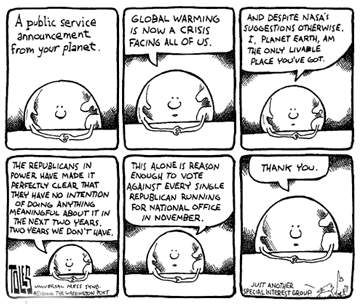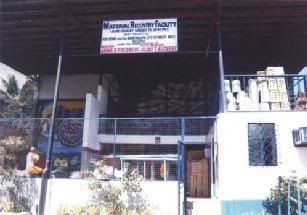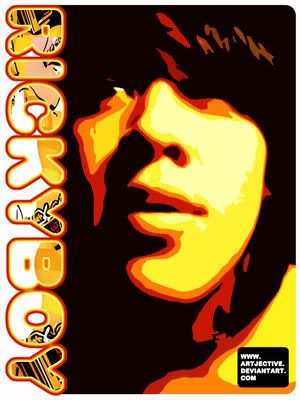
Burning fossil fuels such as natural gas, coal, oil and gasoline raises the level of carbon dioxide in the atmosphere, and carbon dioxide is a major contributor to the greenhouse effect and global warming.
You can help to reduce the demand for fossil fuels, which in turn reduces global warming, by using energy more wisely. Here are 10 simple actions you can take to help reduce global warming.
1) Reduce, Reuse, Recycle
Do your part to reduce waste by choosing reusable products instead of disposables. Buying products with minimal packaging (including the economy size when that makes sense for you) will help to reduce waste. And whenever you can, recycle paper, plastic, newspaper, glass and aluminum cans. If there isn’t a recycling program at your workplace, school, or in your community, ask about starting one. By recycling half of your household waste, you can save 2,400 pounds of carbon dioxide annually.
2) Use Less Heat and Air Conditioning
Adding insulation to your walls and attic, and installing weather stripping or caulking around doors and windows can lower your heating costs more than 25 percent, by reducing the amount of energy you need to heat and cool your home.
Turn down the heat while you’re sleeping at night or away during the day, and keep temperatures moderate at all times. Setting your thermostat just 2 degrees lower in winter and higher in summer could save about 2,000 pounds of carbon dioxide each year.
3) Change a Light Bulb
Wherever practical, replace regular light bulbs with compact florescent light (CFL) bulbs. Replacing just one 60-watt incandescent light bulb with a CFL will save you $30 over the life of the bulb. CFLs also last 10 times longer than incandescent bulbs, use two-thirds less energy, and give off 70 percent less heat.
If every U.S. family replaced one regular light bulb with a CFL, it would eliminate 90 billion pounds of greenhouse gases, the same as taking 7.5 million cars off the road.
4) Drive Less and Drive Smart
Less driving means fewer emissions. Besides saving gasoline, walking and biking are great forms of exercise. Explore your community’s mass transit system, and check out options for carpooling to work or school.
When you do drive, make sure your car is running efficiently. For example, keeping your tires properly inflated can improve your gas mileage by more than 3 percent. Every gallon of gas you save not only helps your budget, it also keeps 20 pounds of carbon dioxide out of the atmosphere.
5) Buy Energy-Efficient Products
When it’s time to buy a new car, choose one that offers good gas mileage. Home appliances now come in a range of energy-efficient models, and compact florescent bulbs are designed to provide more natural-looking light while using far less energy than standard light bulbs.
Avoid products that come with excess packaging, especially molded plastic and other packaging that can't be recycled. If you reduce your household garbage by 10 percent, you can save 1,200 pounds of carbon dioxide annually.
6) Use Less Hot Water
Set your water heater at 120 degrees to save energy, and wrap it in an insulating blanket if it is more than 5 years old. Buy low-flow showerheads to save hot water and about 350 pounds of carbon dioxide yearly. Wash your clothes in warm or cold water to reduce your use of hot water and the energy required to produce it. That change alone can save at least 500 pounds of carbon dioxide annually in most households. Use the energy-saving settings on your dishwasher and let the dishes air-dry.
7) Use the "Off" Switch
Save electricity and reduce global warming by turning off lights when you leave a room, and using only as much light as you need. And remember to turn off your television, video player, stereo and computer when you're not using them.
It’s also a good idea to turn off the water when you’re not using it. While brushing your teeth, shampooing the dog or washing your car, turn off the water until you actually need it for rinsing. You’ll reduce your water bill and help to conserve a vital resource.
8) Plant a Tree
If you have the means to plant a tree, start digging. Trees absorb carbon dioxide and give off oxygen. They are an integral part of the natural atmospheric exchange cycle here on Earth, but there are too few of them to fully counter the increases in carbon dioxide caused by automobile traffic, manufacturing and other human activities. A single tree will absorb approximately one ton of carbon dioxide during its lifetime.
9) Get a Report Card from Your Utility Company
Many utility companies provide home energy audits to help consumers identify areas in their homes that may not be energy efficient. In addition, many utility companies offer rebate programs to help pay for the cost of energy-efficient upgrades.
10) Encourage Others to Conserve
Share information about recycling and energy conservation with your friends, neighbors and co-workers, and take opportunities to encourage public officials to establish programs and policies that are good for the environment.
These 10 steps will take you a long way toward reducing your energy use and your monthly budget. And less energy use means less dependence on the fossil fuels that create greenhouse gases and contribute to global warming.
.:.:.:.:.:..:.:.
My Insights
Before getting this article, I’m actually browsing about the pros and cons of Bio Fuel. As I read up to the end of that “Bio Fuel” article, a link about additional readings regarding the environmental awareness appeared. One of these is “Top 10 Things You Can Do to Reduce Global Warming”. At that point in time, I suddenly realized, why should I discuss bio fuel if I can discuss simpler but very useful information in saving the environment. So that’s the story why I chose this article.
Honestly I’m speechless or shall I say wordless?? with this article because it’s very simple and no need for elaboration. Isn’t it obvious? these steps are very simple and effective. Try to visualize, millions of energy and less pollutions will be incurred if all people in the world will follow these steps. At the same time by following these, you could minimize your expenses. And lastly, if we all now practice these 10 simple steps to reduce global warming, just imagine the whole world will be a better place!
Reference:
http://environment.about.com/od/globalwarming/tp/globalwarmtips.htm
GE117


 But he emphasized more in there most effective projects. First, the Trolley Bin, since Garbage Trucks can’t reach narrow places such as houses near railroads, people usually throw their garbage in passing trains. To resolve this problem, they introduced Trolley Bin. This trolley bins collect garbage in houses near railroads. There are separate day of collection for the Bio and Non-bio waste. This is only implemented in few areas in Muntinlupa. But this is really effective. With the success of the Trolley Bin, it will soon be replicated in other barangays.
But he emphasized more in there most effective projects. First, the Trolley Bin, since Garbage Trucks can’t reach narrow places such as houses near railroads, people usually throw their garbage in passing trains. To resolve this problem, they introduced Trolley Bin. This trolley bins collect garbage in houses near railroads. There are separate day of collection for the Bio and Non-bio waste. This is only implemented in few areas in Muntinlupa. But this is really effective. With the success of the Trolley Bin, it will soon be replicated in other barangays.


